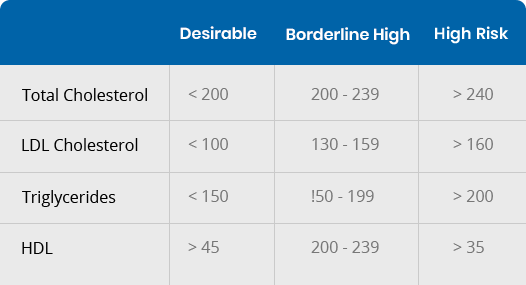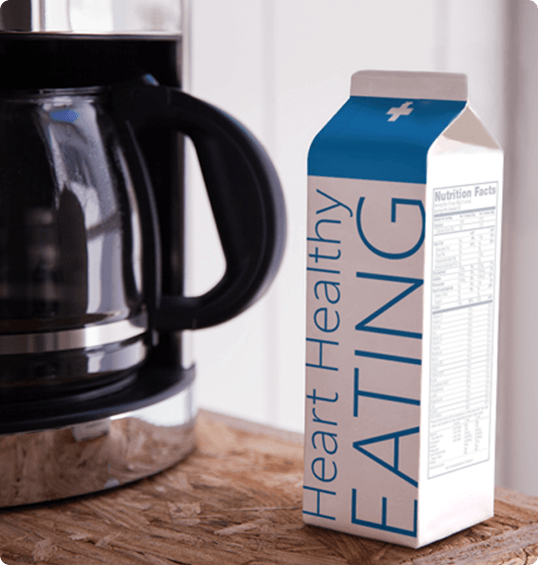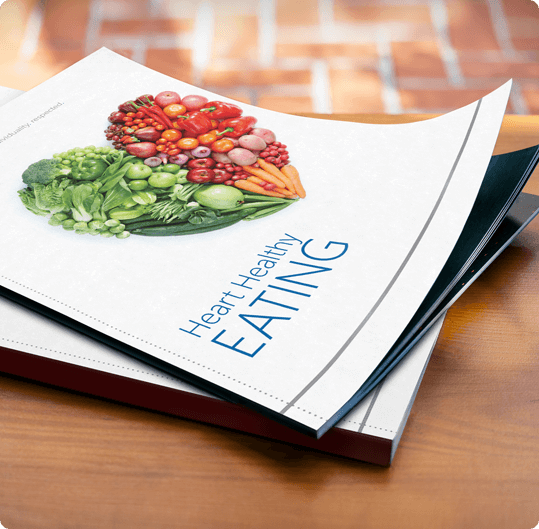Heart Healthy Eating
Learn More About Heart Health
For a great overview of the cardiovascular system and heart function please view the embedded video series from Khan Academy. If you have more questions about heart health and healthy ways to lower your blood pressure please talk to your doctor.
If you are experiencing chest pain or any other symptoms that could be the warning signs of a heart attack or stroke don’t wait – every minute counts.
Heart Disease Risk Factors:
There are many risk factors that can contribute to the development of heart disease. There are some risk factors we can’t control including:
Family History
Male Sex
Age (the older we get the higher our risk becomes)
There are other risk factors we can control; cigarette smoking, high blood pressure, increased LDL (bad cholesterol), decrease HDL (good cholesterol), sedentary lifestyle/inactivity, obesity, and diabetes.
Heart Disease and Blood Lipids
Lipids are a class of nutrients that include various fats, oils, and cholesterol. They are likely our biggest concern when it comes to diet planning for heart health. Our body needs some fat for certain functions, such as manufacturing body tissues or transporting vitamins throughout the body.
However, certain lipids can contribute to coronary artery disease. Coronary artery disease is the buildup of fat, cholesterol, and cells in the lining of the arteries. This buildup is called plaque, which can slowly block blood vessels, limit blood flow and increase the likelihood of a heart attack or stroke.
Oxidation (when free radicals react with cholesterol in the blood, to create a damaging form of cholesterol) can also clog blood vessels. Improving your blood lipid levels and decreasing the oxidation process can help slow, prevent, or possibly reverse the development of coronary artery disease.
The goals of dietary management are to:
Lower Total Fat
Lower Saturated Fat
Very Little or no Trans Fat
Very Little or no Trans Fat
This is an attempt to lower total cholesterol, LDLs and triglyceride levels, thus decreasing the risk of Coronary Artery Disease.
Recommendations for Blood Lipid Levels
The following recommendations apply to adults 20 years and older, who do not have heart disease. All values are in milligrams/deciliter
Individuals with heart disease should aim for an LDL of less than 100, triglyceride of 150 or less and an HDL greater than 45.

What Do These Levels
Mean?
Cholesterol
Cholesterol is a soft, waxy substance. Your body uses cholesterol to function normally and to produce certain hormones.
Cholesterol is present in all parts of the body including the brain, nervous system, muscle, skin, liver, intestines, heart, and skeleton. Your body produces cholesterol to meet certain biological needs. Your body can also use the cholesterol in your diet. Cholesterol is found in animal food. The Cholesterol level of your blood is affected by:
• The cholesterol your body produces.
• The saturated fat, trans fat, cholesterol, fiber, and total calories in your diet.
Total cholesterol is a measure of both HDL and LDL cholesterol in the blood.
High total cholesterol levels increase your risk of heart disease.
Low Density Lipoprotein (LDL) Cholesterol
Cholesterol is carried through the bloodstream in packages called lipoproteins. These lipoproteins are formed in the liver and are transported from the liver to other parts of the body where they can be used by your cells. If the cells do not need all of the LDL, this cholesterol remains in the bloodstream. Over time, the accumulation of this fatty cholesterol in the arteries can clog the arteries and contribute to heart disease. This is why LDL is often called the “bad” cholesterol.
Your LDL cholesterol can often be lowered with a low-fat and high fiber diet, along with regular physical exercise.
(Note: Always consult with your physician before beginning any exercise program.)
High Density Lipoprotein (HDL) Cholesterol
HDL is the “good” blood cholesterol, composed of mostly protein. HDLs carry cholesterol back to the liver for processing or removal from the body. HDLs, therefore, help remove cholesterol from the blood, preventing the accumulation of cholesterol in the blood, and in the walls of the arteries. If HDLs are below 35, it is a risk factor for heart disease, even if your total cholesterol is <200 because your body is not carrying the cholesterol out of the blood to be excreted by the liver. Cholesterol in the form of HDL does not cause problems for your arteries. In fact, you have a lower risk for developing coronary artery disease if your HDLs are high.
To help raise HDLs, lose weight, become more physically active and quit smoking. Losing excess weight can increase your HDLs by 20%. Adding exercise can increase HDLs by 30%!
Triglyceride Level
Your triglyceride level is a measure of the amount of fat circulating in the blood. Triglycerides are a type of fat. The majority of fats you eat in your diet are in the form of triglycerides. After you eat, your body digests the triglycerides contained in foods to use for energy or store as body fat. The liver can also make triglycerides after you have eaten too many calories, especially calories from sugar and alcohol. A mildly elevated triglyceride level does not necessarily increase your risk of heart disease. However, borderline or high levels often go along with other risk factors such as high cholesterol, high LDLs, low HDLs, high blood pressure, obesity, or diabetes.
To lower triglycerides, limit calories from alcohol, sugar, and starchy foods. Also, watch your fat intake and lose weight.
CRP (C-Reactive Protein)
CRP is a measure of low-level inflammation in the body. Having a high level of either CRP or LDL cholesterol can double your risk of heart disease. It is currently not clear how inflammation is linked to heart disease, but the current theory is that it makes cholesterol-filled plaques in arteries more likely to trigger a heart attack.
To lower CRP, stop smoking, lose excess weight, get regular physical activity, and discuss the addition of a cholesterol-lowering medication with your doctor.
All Fat Is Not Created
Equal
Saturated Fat
This fat has all of the hydrogens that it can hold on its chemical chain (it is saturated) and is firm at room temperature. It is found mainly in animal products like butter, meat, milk and cheese. Saturated fat is also found in tropical oils such as palm and coconut oil. Saturated fats tend to raise total cholesterol and LDL cholesterol.
To reduce your saturated fat intake:
• choose low-fat meats, poultry and fish
• eat small portions of meat
• choose low fat or fat-free dairy products
• limit foods made with coconut or palm oil
Trans Fat
Trans fat is the result of adding hydrogen to unsaturated vegetable oils to increase shelf life and to improve texture. The hydrogen is added and crosses (trans) the chemical chain, making the fat more solid at room temperature. Trans fats are found in foods like packaged cookies, crackers, some margarine, processed peanut butter, baked goods and fried foods. They are also naturally occurring in very small amounts in meat and dairy products.
Trans fats tend to increase total and LDL cholesterol and also decrease HDL cholesterol.
The current recommendation for people with heart disease is to limit trans fats as much as possible.
Polyunsaturated Fats
These fats are missing more than one (poly) hydrogen on their chemical chain and are liquid at room temperature. They are found in plant foods like corn oil and soy oil, and also in fatty fish such as salmon and mackerel.
Polyunsaturated fat lowers total LDL cholesterol, but can also lower HDLs.
Omega-3 fatty acids are a type of polyunsaturated fat that can lower triglycerides, total cholesterol, and LDL cholesterol.
Good sources of Omega-3 fats include salmon, albacore tuna, mackerel, herring, sardines, flaxseed/flaxseed oil, walnuts, pine nuts.
Aim for 3 servings per week of foods high in Omega-3 fats. A serving is equal to 3 oz. of the fish listed above or 1 tablespoon of the nuts/seeds listed above.
There are also some fish oil supplements available on the market. If you and your physician decide fish oil supplementation is best for you, look for fish oils that contain at least 1000mg of EPA (eicosapentaenoic acid) and DHA (docosahexaenoic acid) combined. Caution: fish oils can affect blood clotting so avoid taking them if you are taking an anticoagulant such as Coumadin or Warfarin, have had a hemorrhagic stroke, or need surgery.
Monounsaturated Fat
Monounsaturated fats are missing one (mono) hydrogen on their chemical chain and are liquid at room temperature. These fats are found in plant foods like peanuts and peanut butter; vegetable oils like peanut, olive, and canola oil, and avocados. Monounsaturated fat has been shown to lower total and LDL cholesterol while maintaining beneficial HDL cholesterol.
To substitute monounsaturated fats for saturated fats:
• Use soft tub margarine made with canola or olive oil. Example: Promise or Smart Balance
• Use liquid oils, especially olive and canola in food preparation.
• Limit butter, lard, or hardened vegetable shortenings.
Cholesterol
Cholesterol is a fat compound found only in some animal foods like meats, eggs, and full-fat dairy products. Because they are a plant food, peanuts, fruits, vegetables and peanut butter are naturally cholesterol-free. Your body has the ability to manufacture all the cholesterol you need. So there is no dietary requirement for cholesterol. Remember: high blood cholesterol levels are affected more by dietary saturated and trans fat intake than dietary cholesterol intake.
It is still a good idea to limit high cholesterol foods such as:
• Eggs (3-4 yolks per week are OK)
• Liver/organ meats
• Whole milk dairy products
• Shrimp (can be eaten once a week)
Other Changes that Can Help
Increase Your Fiber Intake.
Fiber is the portion of plant foods that our bodies can’t digest. Soluble fibers are substances that dissolve and thicken in water to form gels. Beans, oatmeal, barley, broccoli, oat bran, and citrus fruits all contain soluble fiber. There is evidence that soluble fiber may be helpful in reducing blood cholesterol levels.
Experts recommend that we eat 20-35 grams of dietary fiber a day.
To increase your fiber intake:
• Use whole-grain bread, pasta, and flours
• Eat more fruit and vegetables
• Try brown rice instead of white rice
• Experiment with different high fiber beans
as a protein source for a vegetarian meal.
Plant Stanols and Sterols
Plant Stanols or Sterols are plant-based substances recently singled out by both the American Heart Association and the National Cholesterol Education Program as powerful aids in lowering cholesterol levels. Plant sterols have been shown to reduce cholesterol by blocking the absorption of cholesterol from the foods we eat. Plant stanols make cholesterol unavailable for absorption in the bloodstream. Maximum effects are observed at plant stanol/ sterol intakes of 1-2 grams per day. Two brands of margarine contain either plant stanols or sterols, Benecol and Take Control. The manufacturers of this margarine recommend three servings per day combined with a healthy lifestyle to lower cholesterol. Recently Minute Maid has come out with Premium Heart Wise orange juice that provides a healthful dose of plant sterol as well.
The daily recommendation for plant sterols is 1.3 grams per day.
8 oz. Minute Maid Heart Wise Orange Juice = 1.0 grams plant sterols
The daily recommendation for plant stanols is 5.1 grams per day.
2 tablespoons of Benecol = 1.7g plant stanols
So What Should I Eat?
Balance Calorie Intake
Balance calorie intake and physical activity to achieve or maintain healthy body weight.
Intake of Saturated
Intake of saturated fat to <7% of energy, trans fat to <1% of energy, and cholesterol to <300mg per day.
Eat Healthy Diet
When you eat out, make sure to follow a heart healthy diet and lifestyle recommendations.
Consume Fish
Consume fish, especially oily fish, at least twice a week.
Consume a Diet
Consume a diet rich in vegetables and fruits.
Choosing Lean Meats
Choosing lean meats and vegetable alternatives
Selecting Fat-Free
Selecting fat-free (skim), 1% fat, and low fat dairy products
Minimizing Intake
Minimizing intake of partially hydrogenated fats
Decrease Intake
Decrease intake of beverages and foods with added sugars.
Prepare Foods
Choose and prepare foods with little or no salt
Consume Alcohol
If you consume alcohol, do so in moderation
High Fiber
Choose a whole-grain, high fiber foods
Practical Tips to Implement the American Heart
Association 2006 Diet and Lifestyle Recommendations:
Lifestyle
Know your caloric needs to achieve and maintain a healthy weight
Know the calorie content of the foods and beverages you consume
Track your weight, physical activity, and calorie intake
Prepare and eat smaller portions
Track and, when possible, decrease screen time (e.g., watching television, surfing the web, playing computer games)
Incorporate physical movement into habitual activities
Do not smoke or use tobacco products
If you choose to consume alcohol, do so in moderation (the equivalent of no more than 1 drink in women or 2 drinks in men per day)
Food Choices and Preparation
Use the nutrition facts and panel and ingredients list when choosing foods to buy
Eat fresh, frozen, and canned vegetables and fruits without high-calorie sauces and added salt and sugars
Replace high-calorie foods with fruits and vegetables
Increase fiber intake by eating beans (legumes), whole-grain products, fruits, and vegetables
Use liquid vegetable oils (especially olive and canola oil) in place of solid fats
Limit beverages and foods high in added sugars. Common forms of added sugars are sucrose, glucose, fructose, maltose, dextrose corn syrups, concentrated fruit juice, and honey
Choose foods made with whole grains. Common forms of whole grains are whole wheat, oat/oatmeal, rye, barley, corn, popcorn, brown rice, wild rice, buckwheat, triticale, bulgar (cracked wheat), millet, quinoa, and sorghum
Cut back on pastries and high-calorie bakery products (e.g. muffins, doughnuts)
Select milk and dairy products that are either fat-free or low fat Reduce salt intake by:
Comparing the sodium content of similar products (e.g., different brands of tomato sauce) and choosing products with less salt
Choosing versions of processed foods, including cereals and baked goods that are reduced in salt
Limiting condiments (e.g., soy sauce, ketchup)
Use lean cuts of meat and remove the skin from poultry before eating
Limit processed meats that are high in saturated fat and sodium
Grill, bake or broil fish, meat, and poultry
Incorporate vegetable-based meat substitutes into favorite recipes
Eat whole vegetables and fruits in place of juices
Reading Food Labels
Nutrition labeling is available on almost all packaged and processed foods. Check the amount of saturated fat, trans fat, total fat, cholesterol, sodium, and calories on a food product’s nutrition label. Compare similar products to find the one with the lowest amounts. Don’t forget to compare the serving size as well.
Things To Remember When Looking at Food Labels
Serving Size
Check this section first. The number of calories and nutrients listed on the label is based on one serving of food. If you are eating twice the serving size, you are getting twice the calories, fat, etc.
Important Nutrients
If you are restricting certain nutrients in your diet compare the levels on several products. Nutrients to watch for and limit: total fat, saturated fat, trans fat, cholesterol, sodium, and sugar. Looking for low saturated fat? Compare saturated fat in crackers and snacks. Nutrients to watch for and promote: fiber.
Percent of Daily Value
These percentages show how the nutrients in one serving of food compare to daily recommendations for a healthy diet. The Percent of Daily Value is based on a 2,000 calorie diet. If your calorie requirements are lower, for example, if you are a female with low to moderate activity, your calorie needs will be less.
Ingredients
The ingredients are listed from the greatest to least amount in the product.
If healthy ingredients are listed first, then the food is made mostly of ingredients that are good for us. For example, whole wheat bread or whole-grain cereal will list “whole wheat fl our” first and “sugar” will be listed toward the end of the list. Look for these ingredients to indicate the presence of saturated fat, trans fat or cholesterol:
• Animal, bacon fat
• Cocoa butter
• Coconut, coconut oil
• Whole milk solids
• Cream
• Egg and egg yolk solids
• Hardened fat or oil, lard
• Hydrogenated/partially hydrogenated vegetable oil
• Palm kernel oil, palm oil
Tips to Cut Saturated Fat
Almost any moist ingredient can replace the fat in muffins, bread, and biscuits, as well as other baked goods. It is important to realize, though, that some recipes are better candidates for fat reduction than others. Quick bread and muffins are some of the most easily adapted recipes. Coffee cakes, carrot cakes, spice cakes and those yeast bread that naturally have denser textures are also easily made fat-free.
Any cakes and other baked goods that are meant to have a very light, tender texture are the most difficult to modify. However, you can easily eliminate one-half to three-fourths of the fat even in these recipes.
When you modify your recipes, try eliminating only half the fat at first. The next time you make the recipe, try replacing even more of the fat. Whenever you completely eliminate the fat from the recipe, it is best to substitute whole wheat fl our for at least one-third of the white fl our, or to substitute oat bran for one-fourth of the white fl our.
This will help to maintain a pleasing texture. As you begin working with fat substitutes, you will learn each type of fat substitute has its own set of “rules”- guidelines that will allow you to successfully modify your particular recipe.
Modified Recipes Using Fat
Substitutes
Replace part or all of the butter, margarine, or other solid fat in muffins, bread, biscuits, scones, and cakes with half as much fat substitutes
Replace part or all of the oil with a three-fourths as much fat substitute. Mix up the batter, and add more substitute if the batter seems too dry
Replace each whole egg with two egg whites
Reduce the oven temperature by 25 degrees F. Check for doneness a few minutes before the end of the usual baking time
Other Tips for Modifying
Fat
Brown meat under the broiler without added fat, then rinse with warm water to remove some of the fat
Chill soup; lift off the congealed fat
Remove the skin of chicken or turkey before baking
Bake, broil, microwave, poach, roast, or grill instead of frying
If you do fry, uses a nonstick pan and a non-stick cooking spray or a small amount of olive or canola oil
*The texture of baked goods may be different when you use these substitutes.
“Light” margarine is not recommended for baking. Experiment to find out what works best for you.
*Some salad dressings, processed cheeses and cottage cheese are very high in sodium.
Omit if on a low sodium diet or substitute a product that is low in sodium and fat.
Eating Out
Choose restaurants that offer lower fat choices
Control portion sizes by asking for a small serving, sharing a dish with your tables-mate, or taking some home
Ask questions about how the food is prepared. Ask for gravies, sauces, salad dressings, and syrups on the side
Ask to substitute a salad or baked potato for chips or fries
High Blood Pressure
and Diet
A diet lower in sodium is often recommended for people with heart disease or high blood pressure. A high sodium intake may increase the volume of fluid in the body of salt-sensitive individuals. Lowering your sodium intake reduces this volume and aids in reducing high blood pressure. A diet rich in fruits, vegetables and low-fat dairy products and low in saturated and total fat has been proven to help reduce blood pressure.
Things you can do to decrease the
sodium in your diet
Avoid using salt at the table
Use no salt or only half the amount of salt normally used for cooking
Use a salt substitute, unless potassium is restricted (talk to your doctor to find out if salt substitutes are safe for you to use)
Use frozen, fresh or low salt canned vegetables
If you do buy canned vegetables or fruit put them in a strainer and raise them underwater to eliminate some of the sodium
Avoid processed foods that contain large amounts of sodium, such as convenience and processed foods (unless labeled low sodium)
Look for items with 300mg of sodium or less per serving
Use herbs and spices for flavor instead of salt.
Excercise
Eating right is just one important way you can help reduce your risk for heart disease. Physical activity is another. Individuals who are physically active are less likely to be overweight and more likely to have favorable levels of total blood cholesterol than their peers who are not active. Exercise can include aerobic activities like jogging, walking, biking, swimming, cross country skiing, and dancing as well as routine daily activities like taking the stairs instead of the elevator and mowing the lawn. Remember to start small and gradually work up to a goal of physical activity 4-5 days per week. You should always consult with your physician before starting any exercise program.
Suggested Cookbooks
The New American Heart Association Cookbook, 25th Anniversary Edition, Times Books
American Heart Association Quick & Easy Cookbook, Time Books
Eat More, Weigh Less
By: Dean Ornish
The New Laurel’s Kitchen
By: Laurel Robertson, Carol Hinders and Brian Ruppenthal
Moosewood Restaurant Low-Fat Favorites
By: The Moosewood Collective
Additional Resources
Resource 1
Courtney Prasch, RD, CD
Barb King, RD, CD
Agnesian HealthCare Clinical Dietitians
430 E. Division St.
Fond du Lac, WI 54935
920.926.4681
920.926.4672
[email protected]
[email protected]
Resource 2
Kate Thoreson, RD, CD
Agnesian HealthCare Outpatient Dietitian
439 E. Division St.
Fond du Lac, WI 54935
920.926.4674
[email protected]
Resource 3
Lynn Ann Wagner, RD, CD
Agnesian HealthCare Clinical Dietitian
Waupun Memorial Hospital
620 West Brown St.
Waupun, WI 53963
[email protected]
Resource 4
Agnesian HealthCare Cardiac
Rehab Program
430 E. Division St.
Fond du Lac, WI 54935
920.926.5040
*Additional resources are independent of Bowes In Home Care and not affiliated with our company or our program.











